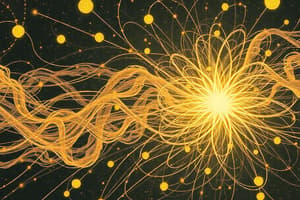Podcast
Questions and Answers
What happens to the total momentum of the car-mosquito system during the collision?
What happens to the total momentum of the car-mosquito system during the collision?
- Increases
- Remains the same (correct)
- Decreases
- Becomes negative
The momentum of the mosquito remained the same after the collision.
The momentum of the mosquito remained the same after the collision.
False (B)
Which object experiences a greater change in velocity during the collision?
Which object experiences a greater change in velocity during the collision?
The mosquito
Impulse is equal in magnitude but opposite in __________ for the car and mosquito.
Impulse is equal in magnitude but opposite in __________ for the car and mosquito.
Match each object with the action it experiences during the collision:
Match each object with the action it experiences during the collision:
Which changed its momentum by more during the collision?
Which changed its momentum by more during the collision?
What is the impulse experienced by Object A?
What is the impulse experienced by Object A?
The final velocity of Object B is greater than that of Object A.
The final velocity of Object B is greater than that of Object A.
The impulse experienced by both the car and the mosquito differs in magnitude.
The impulse experienced by both the car and the mosquito differs in magnitude.
What is the force experienced by Object C?
What is the force experienced by Object C?
Rank the following in increasing order of impulse: a car, a mosquito, and a truck.
Rank the following in increasing order of impulse: a car, a mosquito, and a truck.
The mass of Object A is ______________.
The mass of Object A is ______________.
Match each object to its corresponding impulse value:
Match each object to its corresponding impulse value:
Which object has the highest initial velocity?
Which object has the highest initial velocity?
Both Car 1 and Car 2 have the same mass.
Both Car 1 and Car 2 have the same mass.
Calculate the final velocity of a 20 kg object after experiencing an impulse that increases its velocity by 6 m/s if its initial velocity is 3 m/s.
Calculate the final velocity of a 20 kg object after experiencing an impulse that increases its velocity by 6 m/s if its initial velocity is 3 m/s.
Which of the following scenarios describes an elastic collision?
Which of the following scenarios describes an elastic collision?
The final speed of the 75 kg cart after the collision is more than 10 m/s.
The final speed of the 75 kg cart after the collision is more than 10 m/s.
What is the final velocity of Skater B after pushing off from Skater A?
What is the final velocity of Skater B after pushing off from Skater A?
The type of collision when two ice skaters push off each other is called an ______.
The type of collision when two ice skaters push off each other is called an ______.
Match the car mass with its collision type:
Match the car mass with its collision type:
What is the final speed of the 10 kg cart after colliding with the 5 kg cart?
What is the final speed of the 10 kg cart after colliding with the 5 kg cart?
The momentum is conserved in an inelastic collision.
The momentum is conserved in an inelastic collision.
Calculate the velocity of the boat after throwing a package weighing 5.30 kg at 10 m/s.
Calculate the velocity of the boat after throwing a package weighing 5.30 kg at 10 m/s.
Flashcards
Conservation of Momentum
Conservation of Momentum
The total momentum of a system remains constant in the absence of external forces.
Impulse-Momentum Theorem
Impulse-Momentum Theorem
The change in momentum of an object is equal to the impulse applied to it.
Momentum
Momentum
A vector quantity representing the mass in motion of an object. It is calculated by multiplying the object's mass by its velocity.
Impulse
Impulse
Signup and view all the flashcards
Acceleration
Acceleration
Signup and view all the flashcards
Inertia
Inertia
Signup and view all the flashcards
Friction
Friction
Signup and view all the flashcards
Newton's Third Law of Motion
Newton's Third Law of Motion
Signup and view all the flashcards
Inelastic Collision
Inelastic Collision
Signup and view all the flashcards
Elastic Collision
Elastic Collision
Signup and view all the flashcards
Explosion Collision
Explosion Collision
Signup and view all the flashcards
Kinetic Energy
Kinetic Energy
Signup and view all the flashcards
What is Impulse?
What is Impulse?
Signup and view all the flashcards
How to calculate Impulse?
How to calculate Impulse?
Signup and view all the flashcards
What is Momentum?
What is Momentum?
Signup and view all the flashcards
What is Force?
What is Force?
Signup and view all the flashcards
How to calculate final velocity from impulse?
How to calculate final velocity from impulse?
Signup and view all the flashcards
What is the impulse-momentum theorem?
What is the impulse-momentum theorem?
Signup and view all the flashcards
How to calculate Force?
How to calculate Force?
Signup and view all the flashcards
How to calculate average force?
How to calculate average force?
Signup and view all the flashcards
Study Notes
Momentum and Impulse
- Conservation of Momentum: Momentum is conserved in the absence of external forces. The total momentum of a system remains constant before and after a collision.
- Momentum Change of Objects: If a system's total momentum remains constant, any increase in momentum of one object is balanced by an equal and opposite decrease in the momentum of another object within the system.
- Velocity Change: A smaller mass experiences a larger change in velocity compared to a larger mass, given the same momentum change.
- Impulse: Impulse is the change in momentum. It is equal in magnitude but opposite in direction for interacting objects in a collision.
Ranking Objects by Impulse and Force
- Impulse Calculation: Impulse (I) is calculated as the product of mass (m) and change in velocity (Δv). Impulse (I) = mΔv .
- Force Calculation: Force (F) is calculated as the change in momentum (Δp) divided by the time interval (t) over which the change occurs. Force (F) = Δp/t .
- Impulse Ranking: Rank objects in ascending order of impulse (smallest to largest).
- Force Ranking: Rank objects in ascending order of force (smallest to largest).
Collision Types
- Elastic Collision: Momentum and kinetic energy are conserved in an elastic collision. The total kinetic energy remains constant.
- Inelastic Collision: Momentum is conserved; however, kinetic energy is NOT conserved. Some kinetic energy is transformed into other forms of energy (e.g., heat, sound)
- Explosion Collision: An explosion collision is an example of an inelastic collision where the momentum of the system is conserved. A small amount of mass is broken up into larger quantities of mass, which creates an increase in overall kinetic energy. More kinetic energy is released into the surrounding environment.
Studying That Suits You
Use AI to generate personalized quizzes and flashcards to suit your learning preferences.




